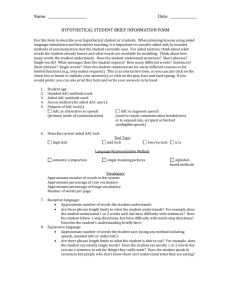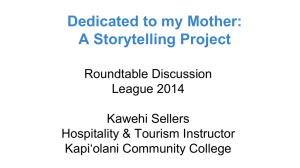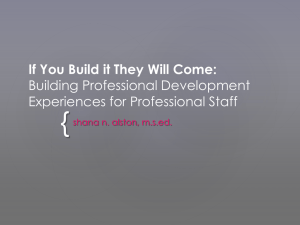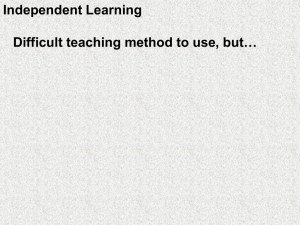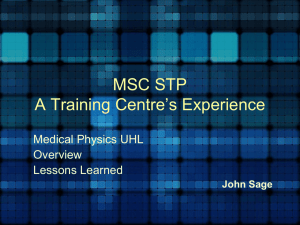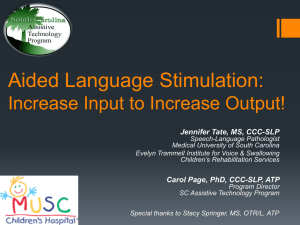What is Communication? - aacworkshop
advertisement
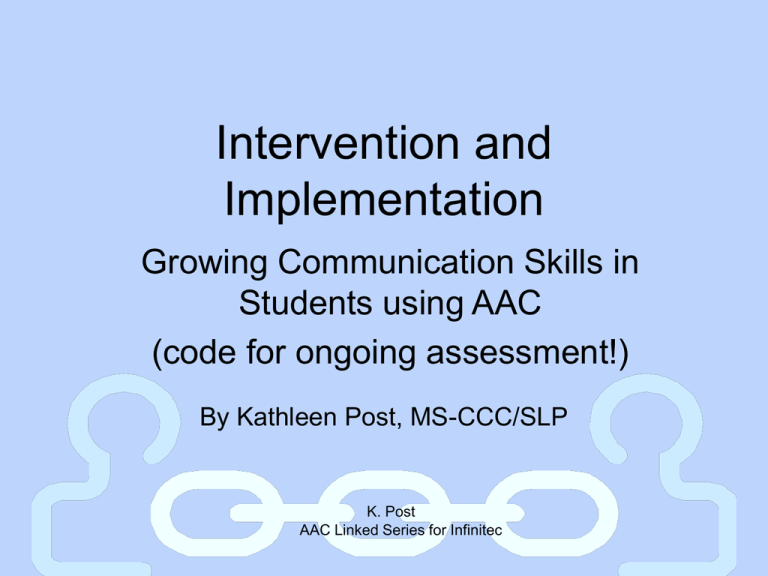
Intervention and Implementation Growing Communication Skills in Students using AAC (code for ongoing assessment!) By Kathleen Post, MS-CCC/SLP K. Post AAC Linked Series for Infinitec Integration with Assessment • You may have determined the motor skills, vision skills, cognitive skills and language skills to match to a system, but you still need to consider COMMUNICATION SKILLS with a system! – Determining a system does not mean competency! What is Communication? Expressing needs and wants Developing social closeness Exchanging information Fulfilling social etiquette routines Multi Modal Communication Unaided Aided Social Networks Unfamiliar Partners Life Long P artners Close Friends or Relatives P aid Workers Acquaintances Levels of Communication Skill • Emerging Communicators – An individual who does not have a RELIABLE method of EXPRESSIVE communication through SYMBOLIC language. • Context Dependent Communicators – An individual who has SYMBOLIC COMMUNICATION that is RELIABLE, but it is limited to particular CONTEXTS or PARTNERS. • Independent Communicator – An individual who has the ability to communicate anything on any topic to anyone in any context. http://depts.washington.edu/augcomm/03_cimodel/commind1_intr o.htp What is communicative competency in AAC? • Four Areas: – Operational Competency – Linguistic Competency – Social Competency – Strategic Competency Barriers to Communication Competency • • • • • • • • Systems not available Lack of training Don’t need it attitude Won’t use their own voice if they have other supports Limitations of vocabulary Access Fear of systems Dependency How do we work past these? • Choose opportunities to communicate – Why? • • • • • Targeting multiple types of communicators Targeting use of multiple systems Targeting differing communication functions Targeting improvement in functional usage Targeting training of staff support What do I use to build Communication Competence? • Access to communication options – Communication signal lists, Communication scrap books. – Picture/photo boards or eye gaze systems. – Voice output technology • Simple • Complex • Vocabulary • Opportunity to practice and use the options in motivating tasks or environments Working it all into the day of a child! • Observe the child throughout their day • Where is the child? What does the child need to say, when? • Work with others! School teams, family members, therapy staff, etc. • Remember- Communication is a work in progress! Be flexible! Develop a Plan • Choose activities – that allow frequent opportunities for communication – With a variety of language functions – With a variety of partners (if possible) How do I do this? complete an observation survey of a student or review schedule of their day/week, etc. WATI or handout example or create your own! Vocabulary • Factors to consider in choosing vocabulary: • • • • • • • age peer group identification cultural and family experiences regular activities special preferences future linguistic development. representation types What type of language to use? Core Vocabulary • General • Needed in many contexts or environments • Frequently used • Made available for use, learned across contexts Fringe or Supplemental Vocabulary • • • • Specific words Typically nouns related to activity Changeable Needed once in a while Core versus Supplemental • Core Vocabulary – Pool of messages that address 90% of the needs for any activity • Fringe or Supplemental – Highly specific messages that are directly linked to the activity. Activity Based Language Sets • Vocabulary directed by the task. • Arranged by the cognitive and language abilities and needs of the learner. • Focus on repetition and learning of symbols and message function (areas of communication function). At School • Think about communication--not just academic concepts! • Work with your school team to integrate symbols, words, messages, systems into the environment! • Different systems for different tasks! • Use ‘Wearable’ devices and keep the communication on the body if possible and tolerated! – Go Talk 5, iTouch with Proloquo2go, etc. • Make manual boards or books to take with! – Small pocket books, communication rings, boards for swimming, pillowcases for bedtime, communication bracelets, etc. Schedules and Task Boards are not Communication Boards • Create a template and use over and over. • First/Then boards. • Reminders about behavior. • Steps to complete a task. How would this look? • Example: Music Time – Present the schedule of activities for the day-show that Music is next. – Present choices of songs according to the cognitive level of the child – Once the song was chosen, use a song board to mediate aided language stimulation while singing. Strategies to Support Communication • • • • Aided Language Stimulation Sabotage Misinterpretation Environmental Communication Training (ECT) • Prompting Hierarchies Aided Language Stimulation Aided language stimulation is when a verbal communication partner “highlights symbols on the user’s communication display as he or she interacts and communicates verbally with the user.” (Goossens’ et al., 1992) http://www.dynavoxtech.com/training/toolkit/details.aspx?id=396 Sabotage Create situations where the child will be forced to communicate. For example, if you were playing with Playdough, you might put the unopened jar in front of the child creating a need for communication. http://www.dynavoxtech.com/training/toolkit/favorites.aspx Misinterpretation Purposely misinterpret a message that has been communicated to create a situation where the child needs to use the communication system. For example, the child may ask you for a puzzle. Although you know the request is for a puzzle, you respond by retrieving different toy. You have recognized the attempt to communicate but misinterpreted the message. This gives the child an opportunity to use the communication system to clarify the message. Environmental Communication Training • Initiated by Dr. Karlan • Specific Training Techniques – Activity Based Objectives – Environment Modifications – Partner Training • Prompting Hierarchy ECT Prompt Hierarchy STEP 1: Pause Focus your attention on the child Pause STEP 2: STEP 3a: STEP 3b: STEP 4: Ask an open question Provide a partial prompt Request for verbalization Provide a full model Pause Pause Pause Pause DON’T FORGET DESCRIPTIVE FEEDBACK Descriptive Feedback Serves three functions: Immediately acknowledges that the listener “heard” the student or young child Confirms that the message sent by the student or young child is the one understood by the listener Can be used to model an expansion of the message expressed by the student or young child Keeping Track • Dynamic AAC Goal Grid • Augmentative & Alternative Communication Profile by Tracy Kovach • Customized Data Sheets Dynamic AAC Goal Grid • Download from http://www.dynavoxtech.com/training/to olkit/ • Means to assess and target specific goals • Merges Competencies, Communication Levels and Prompting Methods Prompting Hierarchy • Natural Cue • Indirect Cue – Visual, gestural, verbal • Direct Verbal Cue • Direct Visual or Physical Cue • Physical Assist http://www.dynavoxtech.com/training/toolkit/favorites.aspx Augmentative & Alternative Communication Profile • Assesses performance in four competency areas over time • Uses Emergent, Context Dependent and Independent definitions of users Teaching Early Scanning Skills • What is auditory/visual scanning? An INDIRECT method of looking and/or listening to CHOICES for communication • Who is a candidate for this process? A child who cannot directly access items on a communication system because of motor or visual impairment • How do you teach these skills? Introduce auditory and/or visual scanning through the use of PARTNER-ASSISTED SCANNING and electronic systems Partner-Assisted Scanning • • • • • • • Write down a list of choices on paper or a communication board. Preview symbols and auditory cues. Explain to the child how you would like him/her to respond. Present the choice one at a time with set time interval (e.g., 5 seconds) If no response, repeat choices with time interval. If still no response, provide verbal support to assist in choice-making process. Give verbal feedback describing the choice made. Steps to Making it Work • Select the activity or subject- make it motivating! • What do you want the student to do? (that’s your objective) • Decide who will do the following: – Gather vocabulary and make it available. – Arrange the environment. – Respond to the communication attempts and use appropriate prompting to make it move toward independence! • Evaluate the activity or opportunity. • Share the information! (Use the handout examples to guide your processes, or use forms from WATI or other sources!) QuickTime™ and a decompressor are needed to see this picture. Begin with the end in mind. -Stephen Covey Activity • Break into small groups – Discuss a current AAC user who may be having challenges in usage. – Brainstorm an activity – Suggest Vocabulary to be available/needed – Any environmental modifications? – Prompting or Facilitation Strategies? – How will and/or what kind of data will be kept? • Be prepared to share key points with group. Contact Information Kathleen Post, MS-CCC/SLP Manager, Assistive Technology Department, Easter Seals DuPage & Fox Valley Region 830 S. Addison, Villa Park, IL 60181 Kpost@eastersealsdfvr.org Infinite member website: www.myinfinitec.org Wiki site for AAC Linked Series: at http://aacworkshop.pbworks.com/

